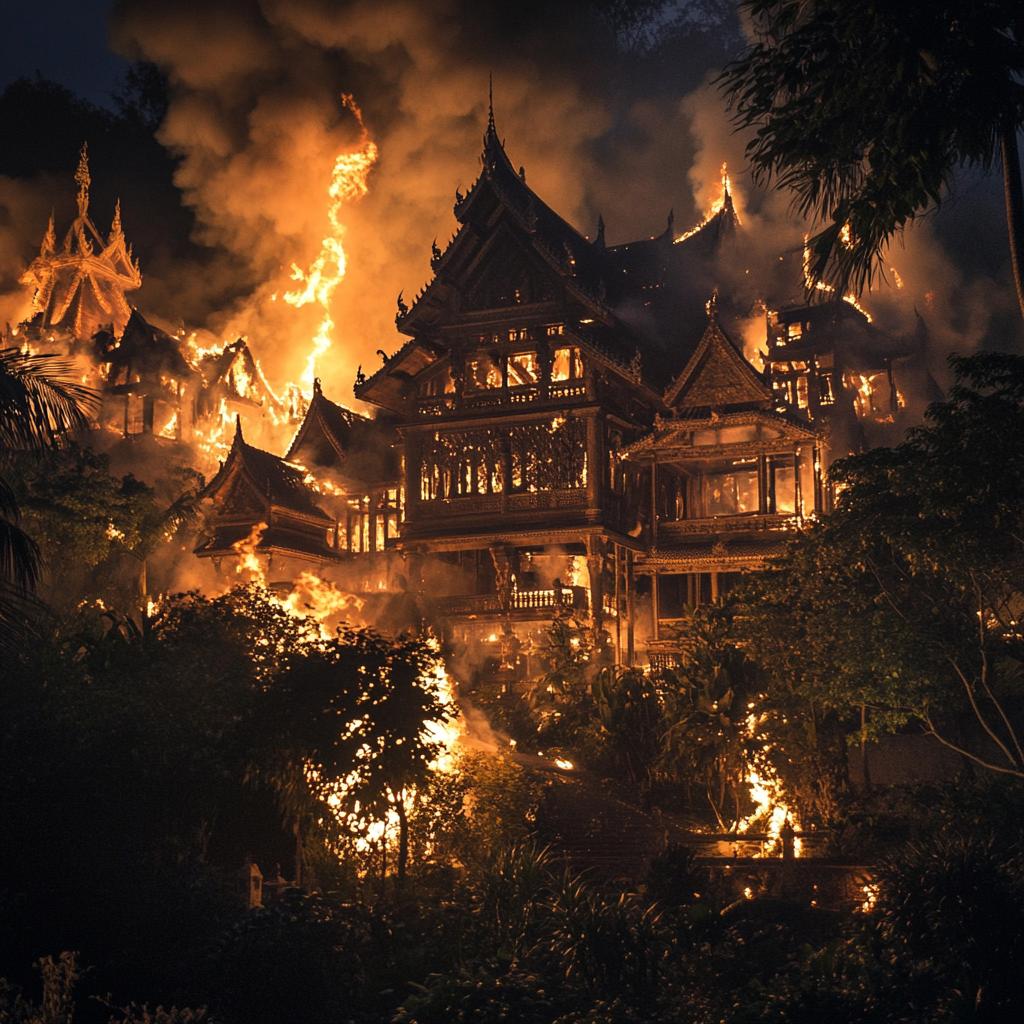As the clock ticked past midnight into the quiet hours of a serene Wednesday morning, the picturesque Dhara Dhevi Hotel in Chiang Mai transformed from a peaceful remnant of Lanna culture into an inferno engulfed by roaring flames. Located in the charming tambon Tha Sala district, this iconic hotel became the latest chapter in a saga perhaps best left in the annals of history books.
Fortunately, amidst the chaos and dazzling display of ember waves and dancing shadows, calamity spared human life. Firefighters wasted no time, charging in with their brigade of glowing engines to quell the angry blaze. With courage as their shield and hoses as their swords, they battled for control, engraving sweat and smoke onto their fiery dance floor for a grueling two hours. By the time the smoke settled, a haunting silence descended, leaving behind a skeletal imprint of what once was—a wooden structure that fronted the legendary estate, now a canvas of charred mystery.
Dhara Dhevi wasn’t just a hotel. It was a sprawling, 153-rai tribute to the grandeur of the ancient Lanna kingdom, a visual symphony eloquently whispering history to every corner of the land since its conception in 2002 and glorious debut in 2004. But beneath its regal facade lay financial cracks, creeping silently until they becamed a cataclysmic chasm—a fact underscored when the Legal Execution Department hammered the symbolic gavel, auctioning it off under a debt-burdened cloud for 2.11 billion baht, a fraction of long overdue receivables tallying up to 4.3 billion baht.
The hotel initially thrived under the guidance of the prestigious Mandarin Oriental Hotel Group, who masterfully orchestrated its operations, personnel-worthy training, and dabbled in the vibrant world of marketing and public relations until they parted ways after a 15-year stint. The hotel continued its search for financial buoyance, culminating in 2015 when Inter Far East Energy Corporation (IFEC) took full reigns, steering what many hoped would be a vessel to uncharted prosperity.
However, no crystal ball could have predicted the global turbulence brought on by the Covid-19 pandemic. The previously bustling grounds of Dhara Dhevi echoed with the deafening silence brought on by temporary closure, a move necessitated by a financial nosedive as liabilities outpaced the influx. As debts mounted, the melody of employment soured, with the hotel unable to meet the demands of staffing costs and soaring utility bills, rising to a cacophony of millions of baht each month.
As despair loomed and time ticked away opportunities, a proposed rehabilitation plan tendered in June 2020 to salvage what remained was quashed by the stern gavel of the Appeal Court. The resulting aftershock left hundreds of employees adrift, onlookers to an unavoidable declaration—bankruptcy.
The Dhara Dhevi Hotel, with its grandeur reduced to embers and legends scarred by economic trials, stands as a poignant tale of magnificence, ambition, and the formidable challenge of perseverance amidst adversity. Its fiery tale remains seared into the fabric of time, a reminder that even the most majestic of reaches sometimes end in a blaze of the unexpected.


















It’s a shame that such a culturally significant place like the Dhara Dhevi succumbed to financial woes. This fire feels like a metaphor for its unfortunate end.
I don’t think it’s just about the money. The pandemic has been tough on all businesses, and some can’t survive, no matter how historic or grand they are.
You’re right, Tommy. It’s heartbreaking to see the pandemic wipe out even storied businesses, but it shows how fragile our economy can be.
I can’t help but think they could have done more to save it. Better management might have prevented this tragedy.
Easier said than done, Kendra. With the kind of debt they were in, I’m not sure better management alone would have been enough.
I still remember my visit a few years back. The architecture was breathtaking—I can’t believe it’s all gone now.
Absolutely agree! It was like stepping into another world, tremendous loss for tourism in Thailand.
Indeed, Annie. Chiang Mai has lost a gem that can’t be replaced.
Not quite! The memory lives on in the hearts of those who visited. We should focus on preserving its story.
This is just another example of how beauty and opulence can’t sustain a business. Financial sustainability is often overlooked.
True that, Kara. In today’s world, it’s all about the balance sheet. Unfortunately, beauty doesn’t pay the bills.
Sad but true, Paul. Maybe this will serve as a lesson for future business ventures.
It might be time to rethink how historical structures like Dhara Dhevi can be preserved amidst modern economic challenges.
I agree. Perhaps some government intervention could help protect culturally significant sites?
Yes, exactly! These places are national treasures and deserve support.
While I’m sympathetic, let’s face it: they bit off more than they could chew. The signs were there, and they ignored them.
Can we talk about how much paper wealth is wasted to build these massive structures that end up like this?
Ivy, it’s called speculative investment. The problem is poor risk assessment and over-leverage.
Maybe speculative investment needs more regulation then.
It’s ironic that what was meant to be a sanctuary for history fell to the very contemporary issue of economic survival.
Do you think something new will be built in its place, or is the site too ‘haunted’ by its past now?
Likely someone will try to revive it. Land like that in Chiang Mai is too valuable to stay dormant.
I hope they honor its legacy if they do rebuild.
I think the death of Dhara Dhevi might actually inspire other places to rethink their long-term planning strategies.
Visited last year, I never imagined it could go up in flames! An unforgettable piece of Chiang Mai’s identity now lost.
Ugh, this is such a colossal loss! 😢 Why are we not doing more to protect landmarks from economic ruin?
Because we’re too focused on short-term gains and not enough on preserving our legacy.